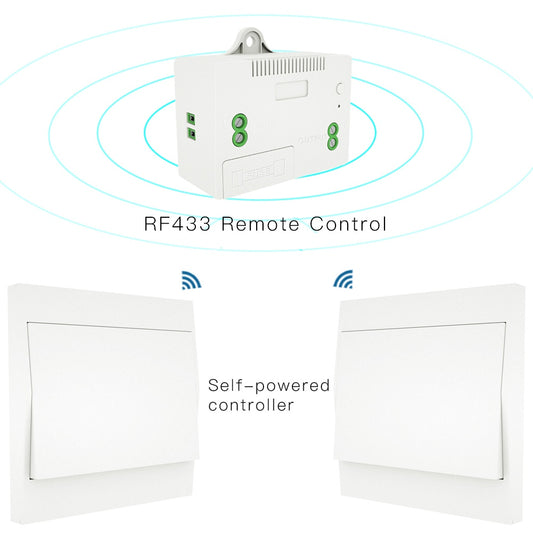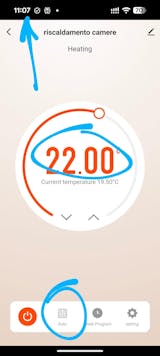Enhance Your Home Automation with MOES RF433 Transmitters
Smart home automation has revolutionized the way we interact with our living spaces. From controlling lighting and climate to managing curtains and other home devices, automation enhances both convenience and efficiency. One of the core components of this technology is reliable, low-power transmitters, and MOES RF433 Transmitters are designed to provide seamless control for a wide range of devices in your home.
What Are RF433 Transmitters?
An RF433 transmitter is a radio frequency-based remote control device used to send signals to compatible smart home modules, such as curtain motors, lighting systems, and ceiling fans. RF433 refers to the 433 MHz frequency used to transmit signals wirelessly between the transmitter and receiver. This technology allows for remote control and automation of various devices within your home, adding both convenience and energy efficiency to your daily routine.
MOES RF433 transmitters are perfect for anyone looking to automate and simplify their environment. With multi-channel remotes and the ability to control up to 9 devices independently, you have more control than ever over your home automation system.
Why Choose MOES RF433 Transmitters?
Multi-Device Control with Ease
MOES RF433 transmitters come equipped with up to 9 channels, allowing you to control multiple devices at once. Whether you want to automate curtains or blinds, lighting systems, or fans, our transmitters ensure you can do so with just one device. Say goodbye to manually adjusting each device and enjoy the freedom of having your entire home at your fingertips.
Easy Integration with Smart Home Systems
MOES RF433 transmitters are designed to integrate seamlessly into your existing smart home setup. Whether you use Alexa, Google Assistant, or Tuya, you can easily sync your RF433 transmitter with these platforms to provide even more control options. Whether you prefer using a voice assistant, a mobile app, or a remote control, MOES transmitters adapt to your needs, providing a convenient and personalized experience.
No App Required for Basic Operation
One of the key advantages of the MOES RF433 Transmitter is its ability to work independently without requiring a smartphone app. This feature is perfect for those who want quick, simple control without the need for additional software. With easy-to-understand button configurations, you can enjoy the benefits of smart automation without the hassle of apps or complicated setups.
Sleek and Practical Designs
The design of MOES RF433 transmitters is built to seamlessly fit into modern interiors. Our transmitters are available in sleek wall-mounted or handheld models, giving you the flexibility to choose a device that suits your space and style. Whether you need a transmitter that blends with your wall decor or one that fits comfortably in your hand, MOES has an option for every home.
Durable and Long-Lasting
Each MOES RF433 transmitter is made from high-quality materials, ensuring longevity and reliability. You can trust that your transmitter will continue to function smoothly for years, providing consistent performance and eliminating the need for frequent replacements.
Applications of MOES RF433 Transmitters
MOES RF433 transmitters offer versatile control for various devices in your home, including curtains, lighting, ceiling fans, and home theater systems.
Automating Curtains and Blinds: Effortlessly control your curtains and blinds, adjusting them via remote, voice assistant, or app.- Lighting Control: Pair with existing light modules to independently control lights, saving time and energy.
- Ceiling Fans: Automate fan operation, adjust speeds, and integrate with other smart systems.
- Home Theater Systems: Control lighting, fans, and curtains for a fully automated entertainment experience.
- Simplifying Routines: Automate tasks like opening curtains, turning off lights, or adjusting fans at specific times, all with ease.
FAQ
1. Conventional use for transmitter switches
Transmitter switches are primarily used in smart homes or commercial setups to wirelessly control devices such as lights, curtains, fans, or other electrical appliances. They replace conventional wall switches or remote controls, enabling centralized or remote management of multiple devices without complex wiring. Typical applications include:
- Lighting automation (turning lamps or LED luminaires on/off)
- Curtain or blind control
- Multi-room device management
- Energy-saving scenarios by scheduling device operation
2. How does the RF Transmitter for switching LED luminaires on and off work?
An RF transmitter sends a radio frequency signal to a compatible receiver connected to the LED luminaire. When the transmitter switch is activated, it emits a coded signal recognized by the receiver, which then toggles the LED luminaire on or off. Some advanced transmitters allow multiple control modes, such as dimming, group control, or timed operation.
3. What is the detection range of the RF Emitter sensor?
The detection or operational range of an RF transmitter depends on the device’s specifications and the environment. Typically, Moes RF transmitter switches can operate reliably within 20–30 meters indoors, while open spaces can allow ranges up to 50 meters. Obstacles like walls or metal structures may reduce the effective range.
4. Is it possible to pair one RF Transmitter with several receivers or luminaires?
Yes. Many RF transmitters support one-to-many pairing, allowing a single transmitter switch to control multiple receivers or luminaires simultaneously. This feature is ideal for scenarios such as controlling all lights in a room, or all curtains in a living area, from a single switch.
5. What type of power supply does the RF Transmitter use and what is its autonomy?
- Battery-powered transmitters: Typically use standard coin-cell or AA/AAA batteries, offering months to years of autonomy depending on usage.
- Self-powered transmitters: Generate energy mechanically (e.g., kinetic energy from pressing the switch), requiring no external battery.
- Mains-powered transmitters: Connect directly to the household power supply for continuous operation.
Self-powered or battery-powered options are popular because they simplify installation and reduce maintenance requirements.





